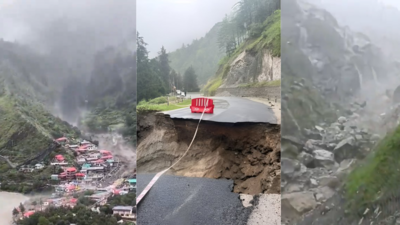A cloudburst has occurred in Sukhi Top, near Dharali, resulting in a blockage of the Badrinath National Highway.
The Himalayan region is currently in the grip of a severe weather crisis, with widespread destruction and high-stakes rescue operations. This urgent threat posed by extreme weather demands immediate attention and action.
On August 5, 2025, severe cloudbursts caused catastrophic flooding in Uttarkashi, Uttarakhand, and Rajouri, Jammu & Kashmir, resulting in considerable damage to infrastructure, loss of livestock, and ongoing rescue efforts to save affected villagers. Learn more about the impact and response to this natural disaster.
When natural environments are significantly altered or destroyed for development, the risk of disastrous events, such as floods, increases. This pattern, observed worldwide, highlights how unchecked progress can erode environmental stability. In India, rapid development is often pursued despite clear evidence that ecological mismanagement can lead to catastrophic consequences. These are not natural disasters, but man-made ones, and it's high time we learn from global experiences and adjust our development strategies to protect natural resources.
The ongoing exploitation of natural resources, coupled with rapid urbanisation and industrialisation, has resulted in severe ecological imbalances. These rapid changes are often pursued without adequate consideration of the environmental impact, reflecting a dangerous disregard for geological assessments that are vital for sustainable planning. Despite evidence indicating the risks associated with such unsustainable practices, which can lead to disasters like floods, landslides, and other ecological crises, the urgency for economic development often trumps environmental considerations.
Unchecked development is causing a recurring cycle of environmental destruction, endangering both ecosystems and human lives. The solution lies in prioritising balanced development and learning from past disasters. Only by doing so can we prevent ongoing tragedies and secure a sustainable future.
A devastating cloudburst in the Kheer Ganga river catchment triggered catastrophic flash floods in Dharali, Uttarkashi district. This key village for pilgrims to Gangotri Dham suffered massive destruction as floodwaters surged, demolishing homes, shops, and infrastructure. Dramatic scenes and eyewitness accounts described torrents of muddy water tearing through village streets, destroying buildings, and forcing residents to flee for safety.
Authorities quickly began rescue operations, with SDRF, the Indian Army, and local officials working to locate survivors and clear debris. Initial estimates suggest that approximately 20 to 25 hotels and homestays were destroyed, resulting in significant economic losses. Villagers expressed fears of people trapped under rubble, and widely shared videos showed the panic as villagers scrambled for higher ground.
In a particularly tragic turn of events, nearly 18 goats were swept away in the Banala Patti area of Barkot tehsil, Uttarkashi, following the overflow of the Kud Gadhera stream as a result of relentless heavy rainfall. This incident underscores the extensive and unfortunate impact of the deluge, affecting not only the local human population but also livestock, which are vital for the livelihoods of many residents in the region. The flooding has also caused significant damage to local businesses, resulting in a loss of revenue and disrupting the livelihoods of many residents.
The India Meteorological Department (IMD) has issued a warning regarding the continued heavy rainfall expected in Uttarakhand, particularly emphasising the hilly areas, which are at greater risk of landslides and flooding, with warnings in effect until August 10. In light of these forecasts, authorities have urgently advised both locals and tourists to exercise heightened caution and refrain from venturing into areas that are prone to flooding or landslides. They have also implemented measures, such as setting up emergency shelters and increasing the number of rescue teams, to ensure the safety of residents and tourists.
In Jammu and Kashmir’s Rajouri district, a flash flood tragedy unfolded, compounding the region's crisis. Some migrant labourers have gone missing after being violently swept away by rising waters in the Dhangri stream on August 4. An intensive search operation involving the SDRF, police forces, and enthusiastic local volunteers is currently ongoing, with hopes of tracing the labourer and ensuring his safe return. These ongoing rescue operations are a beacon of hope in these challenging times.
The interconnected incidents of flooding in Uttarakhand and Jammu & Kashmir highlight the severe and far-reaching effects of extreme weather events throughout the Himalayan belt. With the monsoon season in full force, officials are maintaining rigorous vigilance in these vulnerable zones. Efforts concerning both rescue operations and infrastructure assessments are actively ongoing, with emergency teams being dispatched from Harsil and Bhatwari to enhance the speed of relief efforts and evacuations for those affected. The collective efforts of these teams are commendable. Authorities continue to closely monitor weather forecasts to plan and execute further preventive and responsive measures, aiming to mitigate additional risks as the situation unfolds.
Residents in the communities impacted by this natural disaster are left in a state of shock, grappling with the immediate aftermath of displacement and economic ruin. Many families find themselves without homes as businesses lie in ruins, forced to confront the overwhelming challenges presented by this catastrophic event. The primary focus now remains on conducting thorough rescue operations, facilitating efficient rehabilitation efforts, and minimising any further risks as intense rains continue to batter the already beleaguered region. Concerned individuals and organisations must step forward and provide support, whether through donations, volunteering, or advocacy, as both local and national entities respond to this urgent crisis.
Uttarkashi Floods 2025
#Uttarkashi #Floods2025 #JammuAndKashmir #NaturalDisaster #RescueOperations #Cloudburst #Himalayas #EmergencyResponse #MonsoonChaos

